斯坦福卫生经济学教材(Health Economics)杰伊·巴塔查里亚《健康经济学》课程教学资源(PPT课件,英文版)Chapter 24 TIME INCONSISTENCY AND HEALTH

CHAPTER 24 TIME INCONSISTENCY AND HEALTH
CHAPTER 24 TIME INCONSISTENCY AND HEALTH
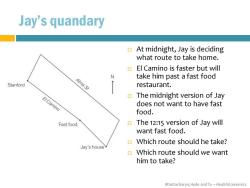
Jay's quandary At midnight,Jay is deciding what route to take home. El Camino is faster but will N take him past a fast food Stanford Alma St restaurant. The midnight version of Jay E日Camino does not want to have fast food. Fast food The 12:15 version of Jay will want fast food. Which route should he take? Jay's house Which route should we want him to take? Bhattacharya,Hyde and Tu-HealthEconomics
Bhattacharya, Hyde and Tu – Health Economics Jay’s quandary At midnight, Jay is deciding what route to take home. El Camino is faster but will take him past a fast food restaurant. The midnight version of Jay does not want to have fast food. The 12:15 version of Jay will want fast food. Which route should he take? Which route should we want him to take?
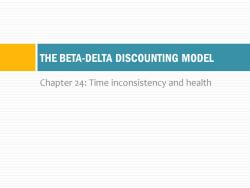
THE BETA-DELTA DISCOUNTING MODEL Chapter 24:Time inconsistency and health
Chapter 24: Time inconsistency and health THE BETA-DELTA DISCOUNTING MODEL
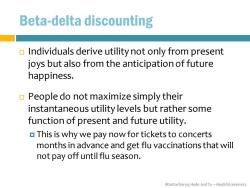
Beta-delta discounting Individuals derive utility not only from present joys but also from the anticipation of future happiness. People do not maximize simply their instantaneous utility levels but rather some function of present and future utility. This is why we pay now for tickets to concerts months in advance and get flu vaccinations that will not pay off until flu season. Bhattacharya,Hyde and Tu-HealthEconomics
Bhattacharya, Hyde and Tu – Health Economics Beta-delta discounting Individuals derive utility not only from present joys but also from the anticipation of future happiness. People do not maximize simply their instantaneous utility levels but rather some function of present and future utility. This is why we pay now for tickets to concerts months in advance and get flu vaccinations that will not pay off until flu season

Beta-delta discounting To account for this fact,economists model overall utility as a weighted sum of instantaneous utility levels from the present period and all future periods: Uoverall=aloday+bUtomorrow+CUthe mext day+··, The coefficients a,b and c are weights that represent the fact that individuals do not necessarily value utility in all periods equally. People value utility now more than utility later. ·Thus a>b>c Bhattacharya,Hyde and Tu-HealthEconomics
Bhattacharya, Hyde and Tu – Health Economics To account for this fact, economists model overall utility as a weighted sum of instantaneous utility levels from the present period and all future periods: Uoverall = aUtoday + bUtomorrow + cUthe next day + · · · • The coefficients a, b and c are weights that represent the fact that individuals do not necessarily value utility in all periods equally. • People value utility now more than utility later. • Thus a > b > c Beta-delta discounting
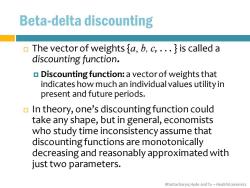
Beta-delta discounting The vector of weights fa,b,c,...is called a discounting function. Discounting function:a vector of weights that indicates how much an individual values utility in present and future periods. In theory,one's discounting function could take any shape,but in general,economists who study time inconsistency assume that discounting functions are monotonically decreasing and reasonably approximated with just two parameters. Bhattacharya,Hyde and Tu-HealthEconomics
Bhattacharya, Hyde and Tu – Health Economics The vector of weights {a, b, c, . . . } is called a discounting function. Discounting function: a vector of weights that indicates how much an individual values utility in present and future periods. In theory, one’s discounting function could take any shape, but in general, economists who study time inconsistency assume that discounting functions are monotonically decreasing and reasonably approximated with just two parameters. Beta-delta discounting
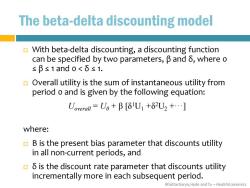
The beta-delta discounting model With beta-delta discounting,a discounting function can be specified by two parameters,B and 8,where o ≤B≤1and0<δ≤1. Overall utility is the sum of instantaneous utility from period o and is given by the following equation: Uoverall=Uo+B [8U1 +82U2+..] where: B is the present bias parameter that discounts utility in all non-current periods,and 6 is the discount rate parameter that discounts utility incrementally more in each subsequent period. Bhattacharya,Hyde and Tu-HealthEconomics
Bhattacharya, Hyde and Tu – Health Economics With beta-delta discounting, a discounting function can be specified by two parameters, β and δ, where 0 ≤ β ≤ 1 and 0 < δ ≤ 1. Overall utility is the sum of instantaneous utility from period 0 and is given by the following equation: Uoverall = U0 + β [δ1U1 +δ2U2 +···] where: Β is the present bias parameter that discounts utility in all non-current periods, and δ is the discount rate parameter that discounts utility incrementally more in each subsequent period. The beta-delta discounting model
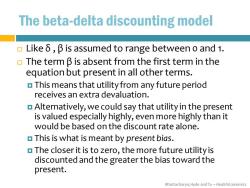
The beta-delta discounting model o Likeδ,βis assumed to range between o and1. The term B is absent from the first term in the equation but present in all other terms. This means that utility from any future period receives an extra devaluation. Alternatively,we could say that utility in the present is valued especially highly,even more highly than it would be based on the discount rate alone. This is what is meant by present bias. The closer it is to zero,the more future utility is discounted and the greater the bias toward the present. Bhattacharya,Hyde and Tu-HealthEconomics
Bhattacharya, Hyde and Tu – Health Economics Like δ , β is assumed to range between 0 and 1. The term β is absent from the first term in the equation but present in all other terms. This means that utility from any future period receives an extra devaluation. Alternatively, we could say that utility in the present is valued especially highly, even more highly than it would be based on the discount rate alone. This is what is meant by present bias. The closer it is to zero, the more future utility is discounted and the greater the bias toward the present. The beta-delta discounting model

TIME-CONSISTENT PREFERENCES Chapter 24:Time inconsistency and health
Chapter 24: Time inconsistency and health TIME-CONSISTENT PREFERENCES

Time-consistent preferences The traditional way of modeling time preference assumes that people are time-consistent in their preferences. Time-consistent preferences:Preferences shared across all selves,so that future selves will not alter a plan that a previous self found optimal. Within the beta-delta model,preferences are time-consistent if,and only if,B=1. If B=1,the resulting utility function is said to exhibit exponential discounting because utility from period t is worth 6t as much as utility in the current period. Bhattacharya,Hyde and Tu-HealthEconomics
Bhattacharya, Hyde and Tu – Health Economics Time-consistent preferences The traditional way of modeling time preference assumes that people are time-consistent in their preferences. Time-consistent preferences: Preferences shared across all selves, so that future selves will not alter a plan that a previous self found optimal. Within the beta-delta model, preferences are time-consistent if, and only if, β = 1. If β = 1, the resulting utility function is said to exhibit exponential discounting because utility from period t is worth δt as much as utility in the current period
按次数下载不扣除下载券;
注册用户24小时内重复下载只扣除一次;
顺序:VIP每日次数-->可用次数-->下载券;
- 斯坦福卫生经济学教材(Health Economics)杰伊·巴塔查里亚《健康经济学》课程教学资源(PPT课件,英文版)Chapter 23 PROSPECT THEORY.ppt
- 斯坦福卫生经济学教材(Health Economics)杰伊·巴塔查里亚《健康经济学》课程教学资源(PPT课件,英文版)Chapter 22 OBESITY.ppt
- 斯坦福卫生经济学教材(Health Economics)杰伊·巴塔查里亚《健康经济学》课程教学资源(PPT课件,英文版)Chapter 21 ECONOMIC EPIDEMIOLOGY.ppt
- 斯坦福卫生经济学教材(Health Economics)杰伊·巴塔查里亚《健康经济学》课程教学资源(PPT课件,英文版)Chapter 20 THE ECONOMICS OF HEALTH EXTERNALITIES.ppt
- 斯坦福卫生经济学教材(Health Economics)杰伊·巴塔查里亚《健康经济学》课程教学资源(PPT课件,英文版)Chapter 02 DEMAND FOR HEALTH CARE.ppt
- 斯坦福卫生经济学教材(Health Economics)杰伊·巴塔查里亚《健康经济学》课程教学资源(PPT课件,英文版)Chapter 19 POPULATION AGING AND THE FUTURE OF HEALTH POLICY.ppt
- 斯坦福卫生经济学教材(Health Economics)杰伊·巴塔查里亚《健康经济学》课程教学资源(PPT课件,英文版)Chapter 18 THE AMERICAN MODEL.ppt
- 斯坦福卫生经济学教材(Health Economics)杰伊·巴塔查里亚《健康经济学》课程教学资源(PPT课件,英文版)Chapter 17 THE BISMARCK MODEL - SOCIAL HEALTH INSURANCE.ppt
- 斯坦福卫生经济学教材(Health Economics)杰伊·巴塔查里亚《健康经济学》课程教学资源(PPT课件,英文版)Chapter 16 THE BEVERIDGE MODEL - NATIONALIZED HEALTH CARE.ppt
- 斯坦福卫生经济学教材(Health Economics)杰伊·巴塔查里亚《健康经济学》课程教学资源(PPT课件,英文版)Chapter 15 THE HEALTH POLICY CONUNDRUM.ppt
- 斯坦福卫生经济学教材(Health Economics)杰伊·巴塔查里亚《健康经济学》课程教学资源(PPT课件,英文版)Chapter 14 HEALTH TECHNOLOGY ASSESSMENT.ppt
- 斯坦福卫生经济学教材(Health Economics)杰伊·巴塔查里亚《健康经济学》课程教学资源(PPT课件,英文版)Chapter 13 TECHNOLOGY AND THE PRICE OF HEALTH CARE.ppt
- 斯坦福卫生经济学教材(Health Economics)杰伊·巴塔查里亚《健康经济学》课程教学资源(PPT课件,英文版)Chapter 12 PHARMACEUTICALS AND THE ECONOMICS OF INNOVATION.ppt
- 斯坦福卫生经济学教材(Health Economics)杰伊·巴塔查里亚《健康经济学》课程教学资源(PPT课件,英文版)Chapter 11 MORAL HAZARD.ppt
- 斯坦福卫生经济学教材(Health Economics)杰伊·巴塔查里亚《健康经济学》课程教学资源(PPT课件,英文版)Chapter 10 ADVERSE SELECTION IN REAL MARKETS.ppt
- 斯坦福卫生经济学教材(Health Economics)杰伊·巴塔查里亚《健康经济学》课程教学资源(PPT课件,英文版)Chapter 01 WHY HEALTH ECONOMICS?.ppt
- 斯坦福卫生经济学教材(Health Economics)杰伊·巴塔查里亚《健康经济学》课程教学资源(试卷习题,英文版)课后判断题及答案 Ch 9 Adverse Selection - The Rothschild-Stiglitz Model.pdf
- 斯坦福卫生经济学教材(Health Economics)杰伊·巴塔查里亚《健康经济学》课程教学资源(试卷习题,英文版)课后判断题及答案 Ch 8 Adverse Selection - Akerlof’s Market for Lemons.pdf
- 斯坦福卫生经济学教材(Health Economics)杰伊·巴塔查里亚《健康经济学》课程教学资源(试卷习题,英文版)课后判断题及答案 Ch 7 Demand for Insurance.pdf
- 斯坦福卫生经济学教材(Health Economics)杰伊·巴塔查里亚《健康经济学》课程教学资源(试卷习题,英文版)课后判断题及答案 Ch 6 The Hospital Industry.pdf
- 斯坦福卫生经济学教材(Health Economics)杰伊·巴塔查里亚《健康经济学》课程教学资源(PPT课件,英文版)Chapter 03 CHAPTER 3 DEMAND FOR HEALTH:THE GROSSMAN MODEL.ppt
- 斯坦福卫生经济学教材(Health Economics)杰伊·巴塔查里亚《健康经济学》课程教学资源(PPT课件,英文版)Chapter 04 SOCIOECONOMIC DISPARITIES IN HEALTH.ppt
- 斯坦福卫生经济学教材(Health Economics)杰伊·巴塔查里亚《健康经济学》课程教学资源(PPT课件,英文版)Chapter 05 THE PHYSICIAN LABOR MARKET.ppt
- 斯坦福卫生经济学教材(Health Economics)杰伊·巴塔查里亚《健康经济学》课程教学资源(PPT课件,英文版)Chapter 06 THE HOSPITAL INDUSTRY.ppt
- 斯坦福卫生经济学教材(Health Economics)杰伊·巴塔查里亚《健康经济学》课程教学资源(PPT课件,英文版)Chapter 07 DEMAND FOR INSURANCE.ppt
- 斯坦福卫生经济学教材(Health Economics)杰伊·巴塔查里亚《健康经济学》课程教学资源(PPT课件,英文版)Chapter 08 ADVERSE SELECTION - AKERLOF’S MARKET FOR LEMONS.ppt
- 斯坦福卫生经济学教材(Health Economics)杰伊·巴塔查里亚《健康经济学》课程教学资源(PPT课件,英文版)Chapter 09 ADVERSE SELECTION - THE ROTHSCHILD-STIGLITZ MODEL.ppt
- 兰州交通大学:《微观经济学》课程教学资源(教案大纲)教学大纲 Microeconomics(负责人:李新文).pdf
- 兰州交通大学:《微观经济学》课程教学资源(教案大纲)微观经济学授课教案(打印版).pdf
- 兰州交通大学:《微观经济学》课程教学资源(案例分析)微观经济学教学案例(打印版).pdf
- 《微观经济学》课程教学资源(书籍文献)西方经济学名著选读.pdf
- 兰州交通大学:《微观经济学》课程教学资源(试卷习题)微观经济学各章习题库及参考答案(打印版,共十一章).pdf
- 兰州交通大学:《微观经济学》课程教学资源(试卷习题)微观经济学试题(A卷)试卷(打印版).pdf
- 兰州交通大学:《微观经济学》课程教学资源(试卷习题)微观经济学试卷(A卷)答案(打印版).pdf
- 兰州交通大学:《微观经济学》课程教学资源(课件讲稿,打印版)第一章 导论(负责人:李新文).pdf
- 兰州交通大学:《微观经济学》课程教学资源(课件讲稿,打印版)第二章 需求曲线和供给曲线以及均衡价格(供给需求和均衡价格).pdf
- 兰州交通大学:《微观经济学》课程教学资源(课件讲稿,打印版)第三章 效用论.pdf
- 兰州交通大学:《微观经济学》课程教学资源(课件讲稿,打印版)第四章 生产论.pdf
- 兰州交通大学:《微观经济学》课程教学资源(课件讲稿,打印版)第五章 成本论.pdf
- 兰州交通大学:《微观经济学》课程教学资源(课件讲稿,打印版)第七章 不完全竞争的市场.pdf
